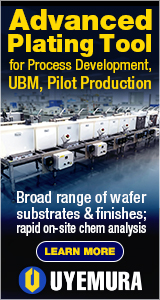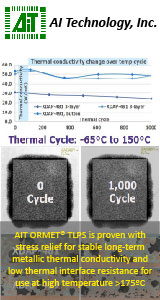|

|
|
| Ask the Experts | ||||||||
|
||||||||
|
January 8, 2019 - Updated October 6, 2008 - Originally Posted Component Damage From IR ReflowWe have an SMT package with J formed leads that crack at the shoulder of the package after IR reflow soldering. What in the reflow process could be causing these defects? R. Y. |
||||||||
| Expert Panel Responses | ||||||||
|
That sounds more like a component manufacturing issue rather than the reflow process. If your reflow is heating the component to the point of lead shoulder failure, the rest of the PCB would probably show signs of overheating as well.
Manager of Assembly Technology IPC Kris Roberson has experience as a machine operator, machine and engineering technician and process engineer for companies including Motorola, and US Robotics. Kris is certified as an Master Instructor in IPC-7711 / 7721, IPC A-610 and IPC J-STD 001.
There are several contributing factors here. A simple solution would be an evaluation of the volume of paste that is being deposited on the board. It sounds like there could be a large deposit of solder that is working against your oven profile. If the solder deposit is extensive, and the joint cools too quickly, that could result in the crack that you are describing. You should be able to contact your stencil vendor and work with them to determine how much paste would be required to properly solder the lead. With the proper volume and location of paste deposited, you may be able to avoid having to change the profile of the oven.
President Integrated Ideas & Technologies, Inc. Mike Ray is founder and president of Integrated Ideas & Technologies, Inc., a manufacturer of SMT stencils. Mike Ray developed the first successful universal frame and holds patents on the AXIS laser system.
The following could be the possible reasons for this failure. 1. Board support in placement and the placement pressure. Too much pressure with direct support under the component could stress the package body. 2. Since it is IR heating check to see if the package body is able to withstand the temperature setting for the IR panel. Possible damage occurring due to high temperature. 3. Check if the component is lead free compatible if the process is lead free. 4. Component age, handling and storage. Old components that have been in storage could have absorbed moisture over a period of time resulting in popcorn delamination. If this is the case try baking the components prior to assembly (125 deg. C for 48 hours would be good) 5. Check the reflow profile to make sure there is no thermal shocking happening to the components. 6. Also check to make sure that the cooling is not too rapid.
President inspīre solutions LLC Bjorn Dahle is the President of inspīre solutions LLC. He has 20 years experience in the electronic manufacturing industry with various manufacturing equipment companies covering pick & place, screen printers and thermal process management.
Without having more detail it is difficult to diagnose the actual issue. With cracked or failed solder joints you would want to do a few things to determine the actual root cause. Is this a sudden issue? In other words can it be related to a specific batch of components and/or PCBs? Take a look at the fracture surfaces, what do you see? Does it appear that the solder joint is just "pulling out" of the solder fillet (sometimes called "foot-in-mud"). If so it could be a plating issue on the components. Is it fracturing at the pad surface? Could it be related to the metalization on the PCB? Those are some concerns to look into. Since you are suspecting reflow issues, perform a profile, being sure to place a thermocouple adjacent to the solder joint in question. If this is a densely populated PCB, with components of different sizes you want to make sure you profile in multiple locations to make sure you have the proper reflow time and temperatures at each location.
Application Engineering Henkel Electronics Dr. Brian Toleno is the Application Engineering Team leader for Henkel Technologies. He is responsible for the technical service and application engineering for Henkel's electronics assembly materials, including solder paste, underfills, PCB protection materials, and underfills.
The black body of the part is a very good absorber of IR radiation. If you put a thermocouple on top of it, you should see how much hotter than the rest of your product it gets. It is likely your part is overheating and the lead frame to overmold junction is being damaged due to melting and/or expansion related stresses. Either that or you have some poorly made parts. If you get a different part with the same package type and it does not have the same problem, go back to your supplier with the problem.
Application Engineering Supervisor Nordson EFD Mr. Vivari has more than 15 years of electronic engineering design and assembly experience. His expertise in fluid dispensing and solder paste technology assists others in identifying the most cost effective method for assembling products.
This sounds like a combination of a oxidized lead surface and a low thermal profile. Check the solderability of the parts through a lab that does wetting balance testing and then have someone assess the reflow profile for the mass of the board and parts. If these areas show okay then check for a barrier film on the J-leaded QFP leads.
President/Senior Technical Consultant Foresite Mr. Munson, President and Founder of Foresite, has extensive electronics industry experience applying Ion Chromatography analytical techniques to a wide spectrum of manufacturing applications.
I suspect that this is the same issue that I have seen on another component type in the past. The leadframe material has too much cold work to begin with so when the sharp lead bend is made at the point where the lead exits the body, the lead material is unable to bend without cracks being initiated. Further thermal and mechanical stresses cause the cracks to propagate and the leads to fail. If this is your failure mode, the leads will always be cracked right at the bend, typically at an angle of about 45 degrees to the package. The end of the break will be relatively flat, with a moderately rough surface when examined under a microscope. If you conclude that this is the failure mode, the component manufacturer is responsible. They used material that was improperly annealed, or not annealed, for the leadframe.
Process Engineer Astronautics Fritz's career in electronics manufacturing has included diverse engineering roles including PWB fabrication, thick film print & fire, SMT and wave/selective solder process engineering, and electronics materials development and marketing. Fritz's educational background is in mechanical engineering with an emphasis on materials science. Design of Experiments (DoE) techniques have been an area of independent study. Fritz has published over a dozen papers at various industry conferences.
It is not entirely clear from the question whether the cracks occur in the solder joint or in the component body although I suspect the latter. To check this, isolate the component from the soldering process by running a few components through the complete reflow thermal cycle and then inspect them for cracking. This will make it much easier to determine where the problem lies and how to resolve it.
Consultant VJ Electronix Harold Hyman has been involved in metallurgical aspects of the electronics industry since the 1950's, and in semiconductor development and engineering for STL, Ediswan & RCA. He later joined HTC, a pioneer of vapor phase soldering and continued industry experience Dynapert, GenRad, Teradyne, SRT and VJ Electronics.
|
||||||||
| Submit A Comment | ||||||||
|
Comments are reviewed prior to posting. You must include your full name to have your comments posted. We will not post your email address. |
|
Free Newsletter Subscription
Circuitnet is built for professionals who bear the responsibility of looking ahead, imagining the future, and preparing for it. Insert Your Email Address |
|

|










